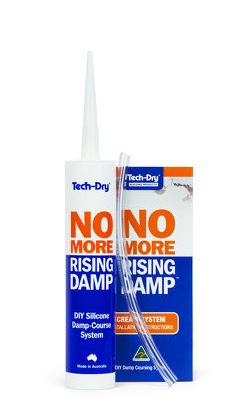Tech-Dry DPC Cream Cartridge 300ml
Tech-Dry DPC Cream is an innovative silane/siloxane cream which has been specifically
formulated as an easy-to-use damp-proof course material to install a durable siloxane
polymer damp-course into brickwork or other masonry walls to permanently stop rising
damp in masonry walls.
Tec-Dry DPC Cream is designed to be installed into the mortar bed of masonry walls. Once
the DPC Cream is injected into the mortar bed, this thixotropic cream can stay in
close contact with the mortar bed and slowly release silane/siloxane into the
capillaries of the mortar bed until the cream is completely absorbed into the mortar
bed. The cream also penetrates the bricks or other masonry substrates above and
below the mortar bed. The silane/siloxane reacts with the mortar bed and the bricks
forming a permanent polysiloxane damp-course within the treated wall.
Installing DPC Cream is easy. There is no special equipment
required to install it. It is suitable for single, double or triple brick walls or any other
types of thick masonry walls including brick, block and stone walls which contain
mortar beds. DPC Cream can be installed from any one side or both sides of the
masonry wall.
Once installed, DPC Cream may take several days to be completely absorbed by the
mortar bed. The mortar bed will become water repellent immediately once the cream
is absorbed. However, it may take up to 7 days or more for the maximum
effectiveness of the water repellency of the mortar bed after the cream is absorbed.
Use Instructions
A hammer drill, a 12mm masonry drill bit, a 23cm caulking gun and a vacuum cleaner
is required to install DPC CREAM. The following instructions should be followed
when installing DPC CREAM:
- It is important that a pilot trial is performed within the masonry wall before application
in order to examine the performance and suitability of DPC CREAM for the purpose. - Locate a mortar joint at a position normally 150mm above ground level, or at or just
above floor level so both sides of the wall are evident. If installation is undertaken from
the inside, carefully remove any skirting boards present to reveal the lowest mortar
course above the floor. - Mark holes at approximately 80 mm apart so that 3 holes can be drilled horizontally
into the mortar bed of each length of brick of approximately 230 mm. The drilling
depth should be approximately 10 mm less than the wall thickness. Avoid drilling
holes directly above the vertical mortar joint as shown in Figure 1. - Completely remove the dust from the holes using a vacuum cleaner fitted with a
proper adapter that can suck the dust from inside of the holes. It is important that NO
drill dust is left in the holes!



